Bednorz W. (ed.) Advances in Greedy Algorithms
Подождите немного. Документ загружается.

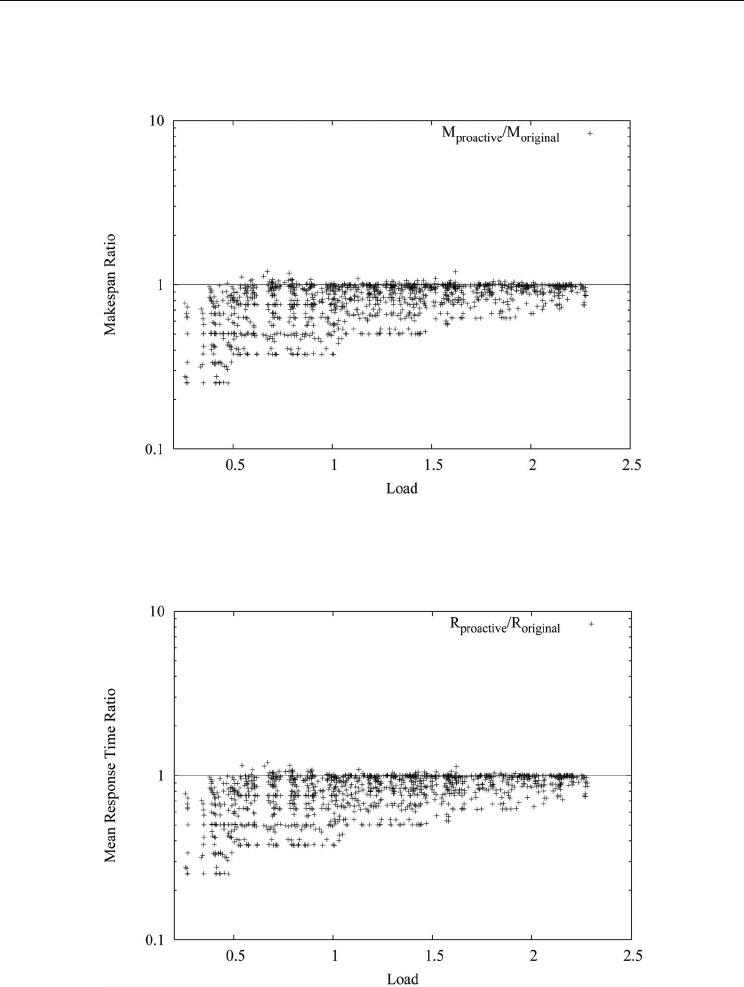
Provably-Efficient Online Adaptive Scheduling of Parallel Jobs Based on Simple Greedy Rules
451
faster execution of jobs which shortens the makespan of the job set. Figure 6 gives evidences
that the proactive RAD improves the performance of our scheduling algorithm under light
load.
Fig. 6. Comparing the proactive RAD against the original for makespan with varying load.
The X-axis represents the load of the system. The Y- axis represents the makespan ratio
between the proactive and original RAD.
Fig. 7. Comparing the proactive RAD against the original for mean response time with
varying load . The X-axis represents the load of the system. The Y-axis represents the mean
response time ratio between the proactive and original RAD.

Advances in Greedy Algorithms
452
7. Related work
Adaptive parallel job scheduling has been studied both empirically [27, 38, 35, 26] and
theoretically [16, 9, 28, 12, 13, 4]. McCann, Vaswani, and Zahorjan [27] introduce the notion
of dynamic equipartitioning (DEQ), which gives each job a fair allotment of processors
based on the job's request, while allowing processors that cannot be used by a job to be
reallocated to the other jobs. Brecht, Deng, and Gu [6] prove that DEQ with instantaneous
parallelism as feedback is 2-competitive with respect to the makespan. Later, Deng and
Dymond [10] prove that DEQ with instantaneous parallelism is also 4-competitive for
batched jobs with respect to the mean response time.
Even though using instantaneous parallelism as feedback is intuitive, it can either cause
gross misallocation of processor resources [32] or introduce significant scheduling overhead.
For example, the parallelism of a job may change substantially during a scheduling
quantum, alternating between parallel and serial phases. Depending on which phase is
currently active, the sampling of instantaneous parallelism may lead the task scheduler to
request either too many or too few processors. Consequently, the job may either waste
processor cycles or take too long to complete. On the other hand, if the quantum length is set
to be small enough to capture frequent changes in instantaneous parallelism, the proportion
of time spent reallotting processors among the jobs increases, resulting in a high scheduling
overhead.
Our previous work in [18] presents a two-level adaptive scheduler AGDEQ, which uses
DEQ as the job scheduler, and A-GREEDY as the thread scheduler. Instead of using
instantaneous parallelism, AGDEQ uses the job's utilization in the past as feedback. AGDEQ
is O(1)-competitive for makespan, and in a batched setting, O(1)-competitive for mean
response time. However, as with other prior work [6, 10] that uses DEQ as the job scheduler,
AGDEQ can only be applied to the case where the total number of jobs in the job set is less
than or equal to the number of processors.
8. Conclusions
We have presented a non-clairvoyant adaptive scheduling algorithm GRAD that ensures
provable efficiency, fairness and minimal overhead.
The history-based feedback mechanism of GRAD can be applied to not only greedy-based
thread schedulers, but many other thread schedulers. For example, GRAD using greedy
rules to map ready threads to allotted processors is suitable for scheduling jobs in more
centralized setting such as data parallel applications. In the centralized setting, the scheduler
has the information of all ready threads at any moment such that it can apply greedy rules
to make effective assignment of ready threads. However, for applications using many
processors and executed with more distributed setting, it can be costly for a scheduler to
collect the ready threads information before making each scheduling decision. In this case,
other than using a greedy thread scheduler, it is more practical to apply a distributed thread
scheduler such as A-STEAL [2, 3] that uses randomized work stealing. A-STEAL performs
as well as A-GREEDY asymptotically [3] in terms of both job completion time and waste,
however, A-STEAL has slightly larger coefficients because it does not have the complete
information on ready threads to make full utilization of the allotted processors. Therefore, a
greedy scheduler like A-GREEDY could be a good choice in the centralized setting, while A-
STEAL can be applied in the distributed setting where a greedy thread scheduler is no

Provably-Efficient Online Adaptive Scheduling of Parallel Jobs Based on Simple Greedy Rules
453
longer applicable. Analogously, one can develop a two-level scheduler by applying the
feedback mechanism in GRAD, and application-specific thread schedulers. Such a two-level
scheduler can be developed to provide both system-wide performance guarantees such as
minimal makespan and mean response time, and optimization of individual applications.
9. Acknowledgements
The preliminary version of GRAD algorithm was published in our paper [19] coauthored
with Charles E. Leiserson. The authors would like to thank Charles for many helpful
discussions on formalizing the analysis and advices on revising the write-up.
10. References
[1] K. Agrawal, Y. He, W. J. Hsu, and C. E. Leiserson. Adaptive task scheduling with
parallelism feedback. In Proceedings of the ACM SIGPLAN Symposium on Principles
and Practice of Parallel Programming, pages 100 - 109, New York City, NY, USA, 2006.
[2] K. Agrawal, Y. He, and C. E. Leiserson. An empirical evaluation of work stealing with
parallelism feedback. In Proceedings of the International Conference on Distributed
Computing Systems, pages 19 - 29, Lisboa, Portugal, 2006.
[3] K. Agrawal, Y. He, and C. E. Leiserson. Work stealing with parallelism feedback. In
Proceedings of the ACM SIGPLAN Symposium on Principles and Practice of Parallel
Programming, San Jose, CA, USA, 2007.
[4] N. Bansal, K. Dhamdhere, J. Konemann, and A. Sinha. Non-clairvoyant scheduling for
minimizing mean slowdown. Algorithmica, 40(4):305-318, 2004.
[5] R. D. Blumofe and C. E. Leiserson. Space-efficient scheduling of multithreaded
computations. SIAM Journal on Computing, 27(1):202-229, 1998.
[6] T. Brecht, X. Deng, and N. Gu. Competitive dynamic multiprocessor allocation for
parallel applications. In Parallel and Distributed Processing, pages 448 - 455, San
Antonio, TX, 1995.
[7] S. Chakrabarti, C. A. Phillips, A. S. Schulz, D. B. Shmoys, C. Stein, and J. Wein. Improved
scheduling algorithms for minsum criteria. In In the Proceedings of Automata,
Languages and Programming, pages 646-657, Paderborn, Germany, 1996.
[8] B. Chen and A. P. A. Vestjens. Scheduling on identical machines: How good is lpt in an
on-line setting? Operations Research Letters, 21:165-169, 1998.
[9] X. Deng and P. Dymond. On multiprocessor system scheduling. In Proceedings of the
ACM Symposium on Parallel Algorithms and Architectures, pages 82-88, Padua, Italy,
1996.
[10] X. Deng, N. Gu, T. Brecht, and K. Lu. Preemptive scheduling of parallel jobs on
multiprocessors. In Proceedings of the ACM-SIAM Symposium on Discrete Algorithms,
pages 159-167, Philadelphia, PA, USA, 1996.
[11] DESMO-J: A framework for discrete-event modelling and simulation. http://asi-
www.informatik.uni-hamburg.de/desmoj/.
[12] J. Edmonds. Scheduling in the dark. In Proceedings of the ACM Symposium on the Theory of
Computing, pages 179-188, Atlanta, Georgia, United States, 1999.
[13] J. Edmonds, D. D. Chinn, T. Brecht, and X. Deng. Non-clairvoyant multiprocessor
scheduling of jobs with changing execution characteristics. Journal of Scheduling,
6(3):231-250, 2003.

Advances in Greedy Algorithms
454
[14] D. G. Feitelson. Job scheduling in multiprogrammed parallel systems (extended
version). Technical report, IBM Research Report RC 19790 (87657) 2nd Revision,
1997.
[15] R. L. Graham. Bounds on multiprocessing anomalies. SIAM Journal on Applied
Mathematics, pages 17(2):416-429, 1969.
[16] N. Gu. Competitive analysis of dynamic processor allocation strategies. Master's thesis,
York University, 1995.
[17] L. A. Hall, D. B. Shmoys, and J. Wein. Scheduling to minimize average completion time:
off-line and on-line algorithms. In Proceedings of the ACM-SIAM Symposium on
Discrete Algorithms, pages 142-151, Philadelphia, PA, USA, 1996.
[18] Y. He, W. J. Hsu, and C. E. Leiserson. Provably e±cient two-level adaptive scheduling.
In Proceedings of the Workshop on Job Scheduling Strategies for Parallel Processing, Saint-
Malo, France, 2006.
[19] Y. He, W. J. Hsu, and C. E. Leiserson. Provably efficient online non-clairvoyant
scheduling. In Proceedings of IEEE International Parallel and Distributed Processing
Symposium, Long Beach, CA, USA, 2007.
[20] K. S. Hong and J. Y. T. Leung. On-line scheduling of real-time tasks. IEEE Transactions
on Computers, 41(10):1326-1331, 1992.
[21] K. Jansen and H. Zhang. Scheduling malleable tasks with precedence constraints. In
Proceedings of the ACM Symposium on Parallel Algorithms and Architectures, pages 86-
95, New York, NY, USA, 2005.
[22] D. Karger, C. Stein, and J. Wein. Handbook of Algorithms and Theory of Computation,
chapter 35 - Scheduling Algorithms. CRC Press, 1997.
[23] H. Kellerer, T. Tautenhahn, and G. J. Woeginger. Approximability and
nonaproximability results for minimizing total flow time on single machine. In
Proceedings of the ACM Symposium on the Theory of Computing, Philadelphia,
Pennsylvania, USA, 1996.
[24] E. L. Lawler, J. K. Lenstra, A. H. G. R. Kan, and D. B. Shmoys. Sequencing and Scheduling:
Algorithms and Complexity, pages 445-552. Elsevier Science Publishers, 1997.
[25] S. Leonardi and D. Raz. Approximating total flow time on parallel machines. In
Proceedings of the ACM Symposium on the Theory of Computing, pages 110-119, El
Paso, Texas, USA, 1997.
[26] S. T. Leutenegger and M. K. Vernon. The performance of multiprogrammed
multiprocessor scheduling policies. In SIGMETRICS, pages 226-236, Boulder,
Colorado, United States, 1990.
[27] C. McCann, R. Vaswani, and J. Zahorjan. A dynamic processor allocation policy for
multiprogrammed shared-memory multiprocessors. ACM Transactions on Computer
Systems, 11(2):146-178, 1993.
[28] R. Motwani, S. Phillips, and E. Torng. Non-clairvoyant scheduling. In Proceedings of the
ACM- SIAM Symposium on Discrete Algorithms, pages 422-431, Austin, Texas, United
States, 1993.
[29] G. Mounie, C. Rapine, and D. Trystram. E±cient approximation algorithms for
scheduling malleable tasks. In Proceedings of the ACM Symposium on Parallel
Algorithms and Architectures, pages 23-32, New York, NY, USA, 1999.
[30] L. S. Nyland, J. F. Prins, A. Goldberg, and P. H. Mills. A design methodology for data-
parallel applications. IEEE Transactions on Software Engineering, 26(4):293-314, 2000.
[31] U. Schwiegelshohn, W. Ludwig, J. L.Wolf, J. Turek, and P. S. Yu. Smart smart bounds
for weighted response time scheduling. SIAM Journal of Computing, 28(1):237-253,
1998.
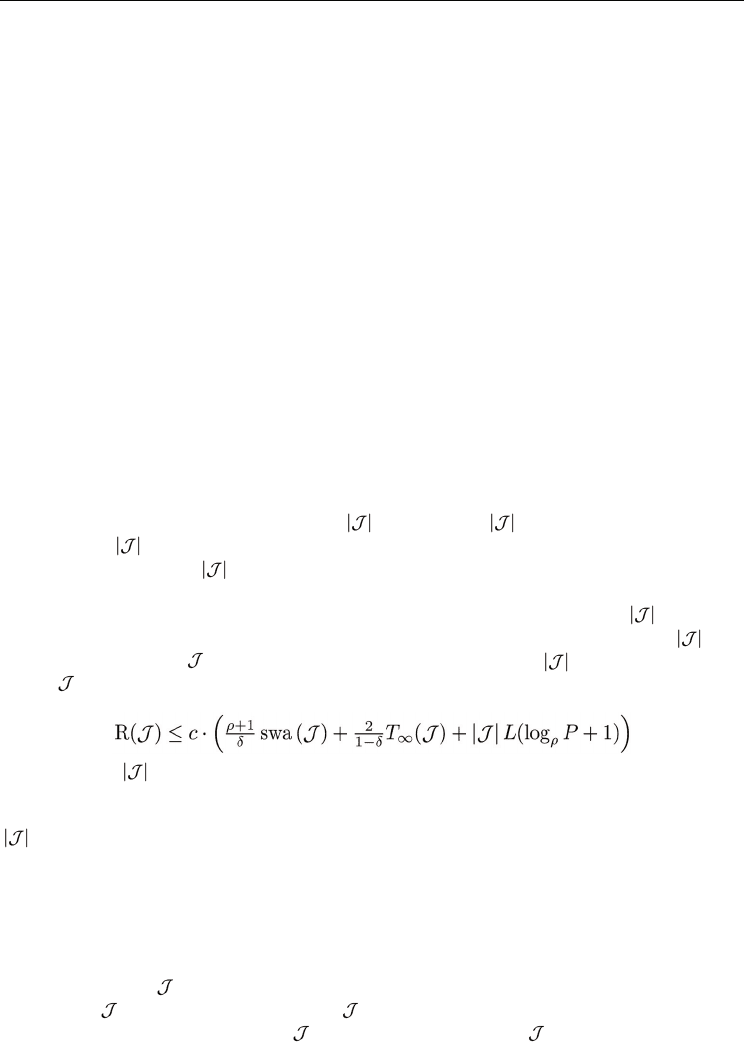
Provably-Efficient Online Adaptive Scheduling of Parallel Jobs Based on Simple Greedy Rules
455
[32] S. Sen. Dynamic processor allocation for adaptively parallel jobs. Master's thesis,
Massachusetts Institute of technology, 2004.
[33] D. B. Shmoys, J. Wein, and D. P. Williamson. Scheduling parallel machines online. In
Proceedings of the IEEE Symposium on Foundations of Computer Science, pages 131-140,
San Juan, Puerto Rico, 1991.
[34] B. Song. Scheduling adaptively parallel jobs. Master's thesis, Massachusetts Institute of
Technology, 1998.
[35] A. Tucker and A. Gupta. Process control and scheduling issues for multiprogrammed
shared-memory multiprocessors. In Proceedings of the ACM Symposium on Operating
Systems Principles, pages 159-166, New York, NY, USA, 1989.
[36] J. Turek, W. Ludwig, J. L. Wolf, L. Fleischer, P. Tiwari, J. Glasgow, U. Schwiegelshohn,
and P. S. Yu. Scheduling parallelizable tasks to minimize average response time. In
Proceedings of the ACM Symposium on Parallel Algorithms and Architectures, pages 200-
209, Cape May, New Jersey, United States, 1994.
[37] J. Turek, U. Schwiegelshohn, J. L.Wolf, and P. S. Yu. Scheduling parallel tasks to
minimize average response time. In Proceedings of the ACM-SIAM Symposium on
Discrete Algorithms, pages 112-121, Philadelphia, PA, USA, 1994.
[38] K. K. Yue and D. J. Lilja. Implementing a dynamic processor allocation policy for
multiprogrammed parallel applications in the Solaris
TM
operating system.
Concurrency and Computation-Practice and Experience, 13(6):449-464, 2001.
Appendix A. Proof of Theorem 4
The proof is divided into two cases - when ≤ P and when > P.
Case 1: when
≤ P
For the first case where
≤ P, GRAD always use DEQ as job scheduler. In our previous
work [18], we show that AGDEQ (the combination of DEQ and A-GREEDY) is O(1)-
competitive with respect to mean response time for batched jobs when ≤ P. The
following lemma from [18] bounds the mean response time of a batched job set with
≤ P.
Lemma 7 [18] A job set
is scheduled by GRAD on P processors where ≤ P. The total response
time R(
) of the schedule is at most
where c = 2 - 2/
+ 1).
Case 2: when jJ j > P
We now derive the mean response time of GRAD for batched jobs for the second case where
>P. Since all jobs in the job set J arrive at time step 0, the number of uncompleted jobs
decreases monotonically. When the number of uncompleted jobs drops down to P or below,
GRAD switches its job scheduler from RR to DEQ. We divide the analysis into three parts.
In Part (a), we prove two technical lemmas (Lemmas 8 and 9) which show the properties of
round robin as the job scheduler. In Part (b), we analyze the completion time of the jobs
which are scheduled by RR during their entire execution. In Part (c), we combine results and
give response time of GRAD in general.
A batched job set
can be divided into two subsets - RR set and DEQ set. The RR set,
denoted as
RR
, includes all the jobs in which are entirely scheduled by RR for their
execution. The DEQ set, denoted as
DEQ
, includes all the jobs in which are scheduled by
RR at the beginning, and by DEQ eventually. There exists a unique quantum q called the
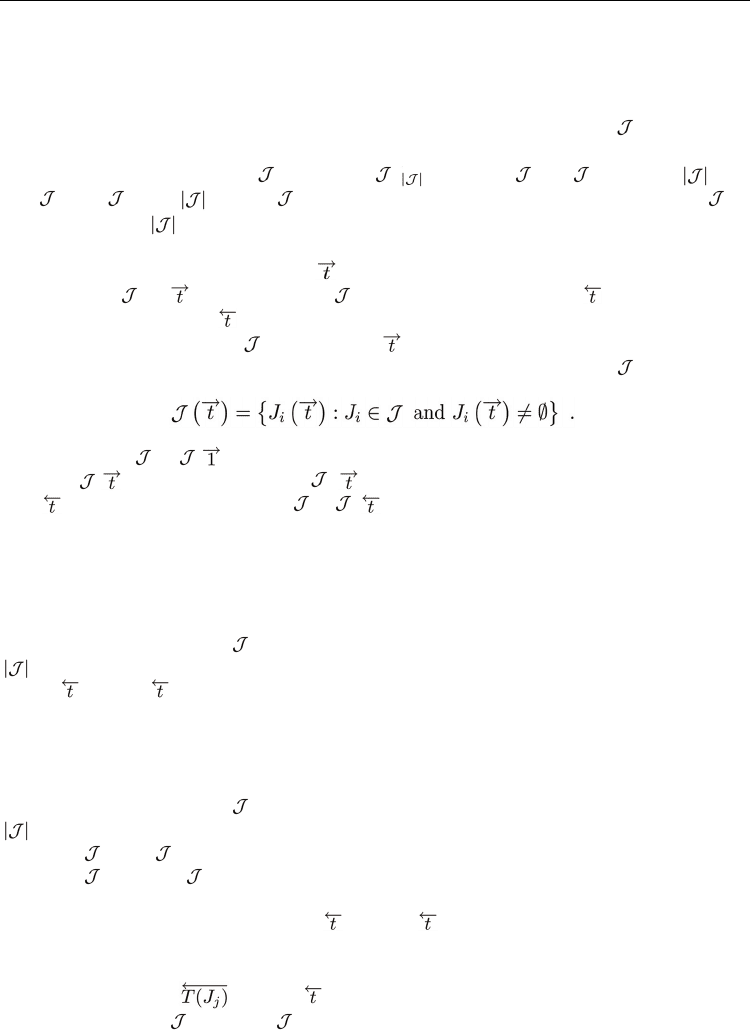
Advances in Greedy Algorithms
456
final RR quantum such that q is the last quantum scheduled by RR, and from quanta q+1
onwards are all scheduled by DEQ. According to RAD, there must be greater than P
uncompleted jobs at the beginning of q, and less than or equal to P uncompleted jobs
immediately after the execution of q. Let denote the total number of uncompleted jobs
immediately after the execution of the final RR quantum. We know that =│
DEQ
│, and ≤
P. Let π denote a permutation that lists the jobs according to the ascending order of their
completion time, i.e. T(J
π(1)
) ≤ T(
π(2)
) ≤ … ≤ T(
π( )
). We have
RR
= {
π(i)
│ 1 ≤ i ≤ - }
and
DEQ
= {
π(i)
│i > - }, i.e.
DEQ
includes the jobs that are completed last, and
RR
includes the other - jobs.
We define two notations - t-suffix and t-preffix, and use them to simplify the notations. For
any time step t, t-suffix denoted as represents the set of time steps from t to the
completion of by = {t, t + 1, … , T( )}, while t-preffix denoted as represents set of
time steps from 1 to t by
= {1, 2, … , t}. We shall be interested in the suffixes of jobs.
Define the t-suffix of a job J
i
∈ to be the job J
i
( ), which is the portion of job J
i
that remains
after t - 1 number of time steps have been executed. The t-suffix of the job set
is
Thus, we have = (
), and the number of uncompleted jobs at time step t is the
number│ ( )│ of nonempty jobs in ( ). Similarly, we can define the t-prefix of a job J
i
as J
i
( ), and the t-prefix of a job set as ( ).
Case 2 - Part (a)
The following two technical lemmas present the properties of round robin as a job
scheduler. The first lemma shows that jobs make almost the same progress on the execution
of their work when they are scheduled by RR. The second lemma relates the work of jobs to
their completion time.
Lemma 8 A batched job set
is scheduled by GRAD on a machine with P processors where
> P. At any time step t scheduled by RR, for any two uncompleted jobs J
i
and J
j
, we have
│T
1
(J
i
( )) - T
1
(J
j
( ))│≤ L, where L is the length of the scheduling quantum.
Proof. Since RR gives an equal share of processors to all uncompleted jobs, for any two jobs
that arrive at the same time, their allotments differ by at most L at any time. When a job's
allotment is 1, its allotted processor is always making useful work. Then the work done for
any two uncompleted jobs differs by at most L at any time before their completion. □
Lemma 9 A batched job set
is scheduled by GRAD on a machine with P processors where
> P. The following two statements are true:
1. If J
i
∈
RR
, J
j
∈
RR
, and T
1
(J
i
) < T
1
(J
j
), then T(J
i
) ≤ T(J
j
).
2. If J
i
∈
RR
, and J
j
∈
DEQ
, then T
1
(J
i
) ≤ T
1
(J
j
).
Proof. We now prove the first statement. Let t = T(J
i
). At time step t, job J
i
completes work T
1
(J
i
). From Lemma 8, we know that T
1
(J
j
( )) ≥ T
1
(J
i
( )) - L = T
1
(J
i
) - L. Since job J
j
completes
after job J
i
, job J
j
takes at least one more scheduling quantum than J
i
to complete its
execution. Thus the work done for J
j
during the period from t to T(J
j
) is at least L. Therefore,
we have T
1
(J
j
) = T
1
(J
i
( )) ≥ T
1
(J
i
( ))+ L ≥ T
1
(J
i
).
For any two jobs J
i
∈
RR
, and J
j
∈
DEQ
, we have T(J
i
) < T(J
j
). By using a similar analysis, we
can prove the second statement.
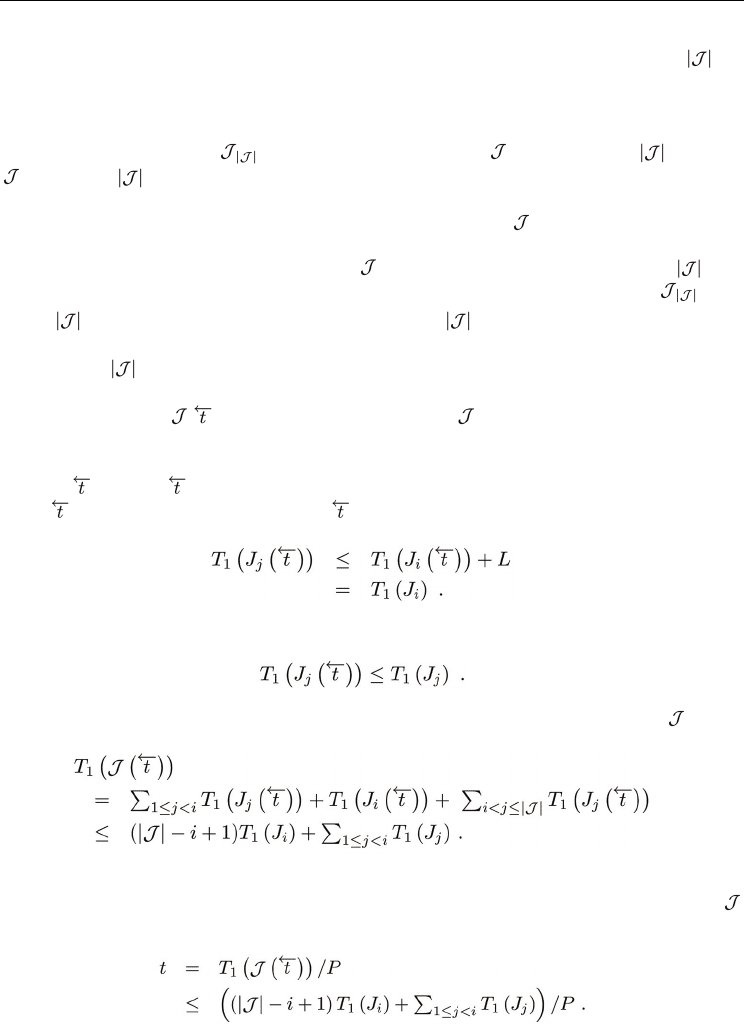
Provably-Efficient Online Adaptive Scheduling of Parallel Jobs Based on Simple Greedy Rules
457
Lemma 9 relates the work of jobs to their completion time. Its second statement tells us that
only the jobs with largest work are scheduled by DEQ eventually, and the other
-
jobs are scheduled by RR for their overall execution. Moreover, according to its first
statement, under the schedule of RR, the jobs with less work are completed more quickly
than those with more work. Consider the jobs according to their work such that
T
1
(J
1
) ≤ T
1
(J
2
) ≤ … ≤ T
1
( ). From Lemma 9, we have
RR
= {J
i
│1 ≤ i ≤ - } and
DEQ
= {J
i
│i > - }.
Case 2 - Part (b)
The following lemma bounds the completion time of the jobs in
RR
where T
1
(J
i
) denotes the
work of a job J
i
.
Lemma 10 GRAD schedules a batched job set on a machine with P processors where > P.
Consider the jobs according to their work such that T
1
(J
1
) ≤ T
1
(J
2
) ≤ … ≤ T
1
( ). For
1 ≤ i ≤
- , the completion time T(J
i
) of a job J
i
is T(J
i
) ≤ (( - i + 1) T
1
(J
i
) +Σ
1 ≤ j < i
T
1
(J
j
))=P+L.
Proof. Since we consider the jobs according to their work, from Lemma 9, we have J
i
∈ J
RR
where 1 ≤ i ≤
- . Such a job J
i
completes its overall execution under the schedule of RR as
job scheduler.
We first evaluate T
1
( ( )), which is the work done for up to a time step t. Suppose that
the job J
i
terminates at the end of a quantum q where T(J
i
) = q(L + 1) - 1. Let t = qL - 1 be the
end of the quantum q - 1, which is L steps before the completion of J
i
. The work done for J
i
in
interval is T
1
(J
i
( )) = T
1
(J
i
) - L. According to Lemma 8, no job completes more than
T
1
(J
i
( ))+ L amount of work in interval . Therefore, for any job J
j
with j > i, we have
(7)
For each job J
j
where j < i, by definition, we always have
(8)
Thus, at time step t, from Inequalities (7) and (8), the total work done for the job set is
(9)
Since RR always allots all processors to jobs, and all allotted processors are making useful
work, RR executes P ready threads at any time step. Thus, the total work done for job set
increases by P at each time step. From Inequality (9), we have
Since T(J
i
) = t + L, we complete the proof. □
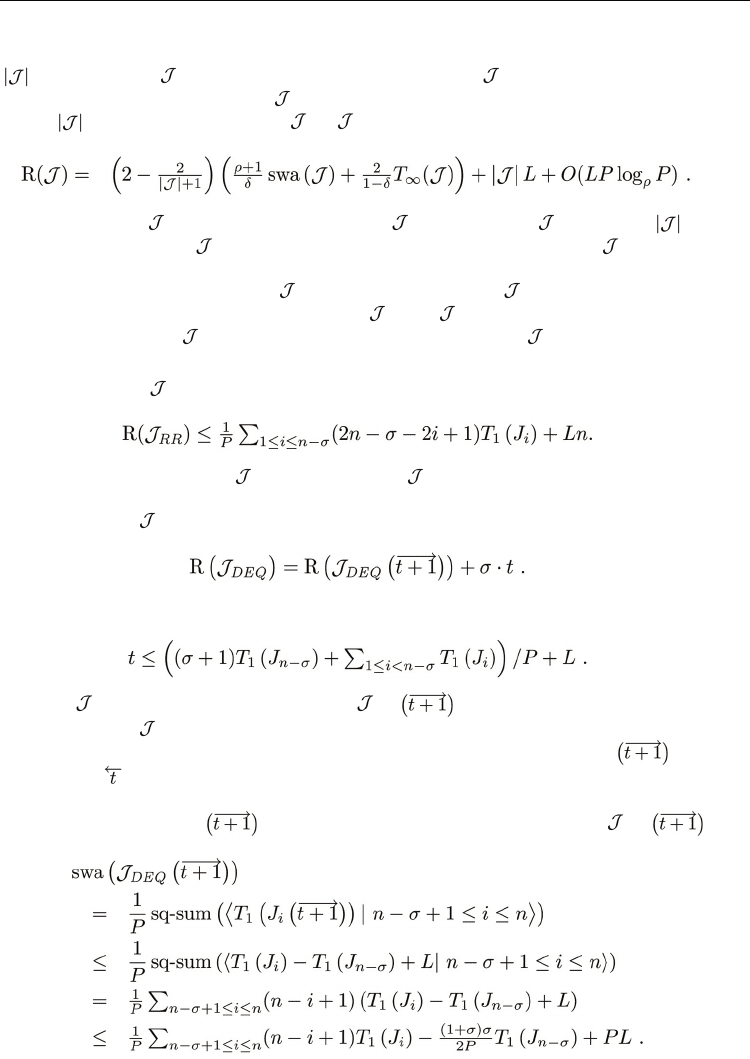
Advances in Greedy Algorithms
458
Case 2 - Part (c)
The following lemma bounds the total response time of job sets scheduled by GRAD when
> P where swa ( ) denotes squashed work area, and T
∞
( ) denotes the aggregate span.
Lemma 11 Suppose that a job set
is scheduled by GRAD on a machine with P processors
where
> P. The response time R( ) of is bounded by
(10)
Proof. The jobs in
can be divided into RR set
RR
and DEQ set
DEQ
. Let n = denote
the number of jobs in
. Recall that denotes the number of jobs in
DEQ
, i.e. ≤ P.
Consider the jobs in the ascending order of their completion time such that T(J
1
) ≤ T(J
2
) ≤ …
·≤ T(J
n
). From Lemma 9, we have
RR
= {J
i
│1 ≤ i ≤ n - } and
DEQ
= {J
i
│i > n - }. We will
calculate the total response time of the jobs in
RR
and
DEQ
respectively.
Step 1: To calculate R(
RR
), we apply Lemma 10. For any job J
i
∈
RR
, its completion time is
T(J
i
) ≤ (1/P)((n - i+1)T
1
(J
i
)+Σ
1 ≤ j < i
T
1
(J
j
))+L according to Lemma 10. Thus, the total response
time of the jobs in
RR
is
(11)
Step 2: We now calculate R(
DEQ
). The jobs in
DEQ
are scheduled by RR until the time
step t = T(J
n-
) at which the job J
n-
completes, and scheduled by DEQ afterwards. The total
response time of
DEQ
is
(12)
From Lemma 10, we know that the completion time of the job J
n-
is
(13)
To get R(
DEQ
), we only need to calculate R(
DEQ
).
Since the job set
DEQ
is scheduled by DEQ as the job scheduler from time step t onwards,
we can apply the total response time bound in Lemma 7 to calculate R(J
DEQ
). During
the interval , job J
n-
completes T
1
(J
n-
) amount of work. From Lemma 8, we know that
each job J
i
with i > n - has completed at least T
1
(J
n-
) - L amount of work. Thus, such a job J
i
has remaining work T
1
(J
i
≤ T
1
(J
i
) - T
1
(J
n-
) + L. The squashed work of
DEQ
is
(14)
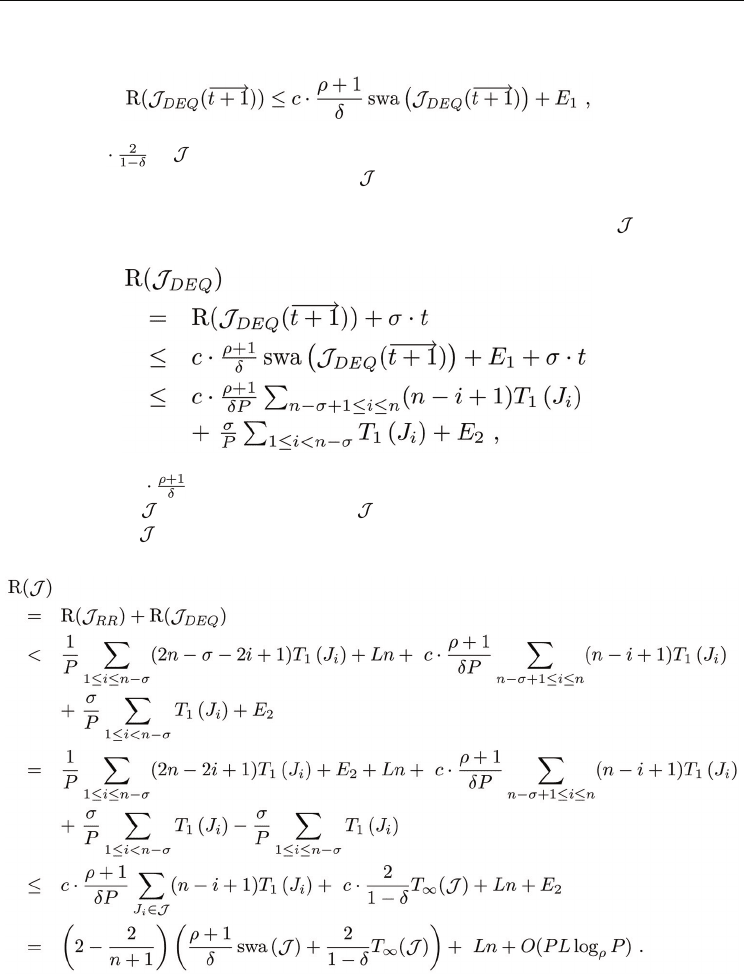
Provably-Efficient Online Adaptive Scheduling of Parallel Jobs Based on Simple Greedy Rules
459
Let the constant c = 2 - 2/(1 + P) < 2. According to Lemma 7, we have
(15)
where E
1
= c T
∞
( ) + cPL(log
ρ
P + 1).
We will now calculate the response time of
DEQ
. Since we know c = 2 – 2/(1 + P) > 1, the
responsiveness parameter ρ > 1, and the utilization parameter ≤ 1, we have c(ρ + 1)= > 2.
Given Equation (12), and Inequalities (13), (14) and (15), the response time of
DEQ
is
(16)
where E
2
= E
1
+ (c + 1)PL .
Step 3: Given R(
RR
) in Inequality (11), R(
DEQ
) in Inequality (16), and c(ρ+1)= > 2, the
response time of
is the sum of them as follows:
□

Advances in Greedy Algorithms
460
Lemmas 7 and 11 bound the total response time of a batched job set
when ≤ P and
> P respectively. Combining them, we have completed the proof of Theorem 4.
□
